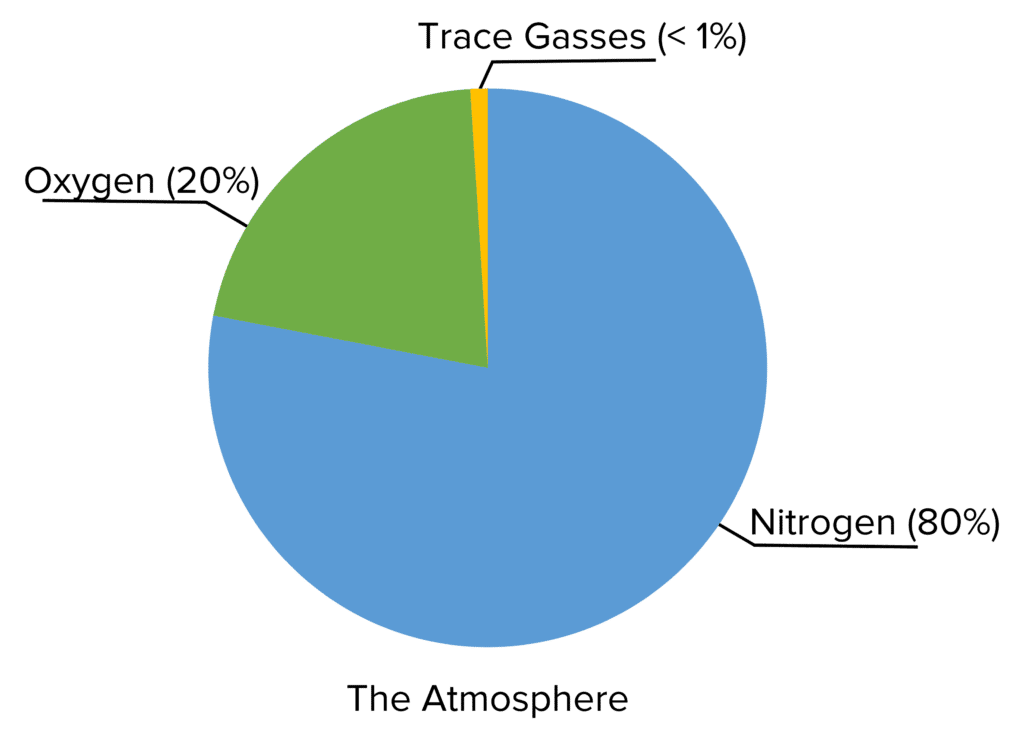The Composition of the Atmosphere
The Composition of the Atmosphere Revision
The Composition of the Atmosphere
Though the modern atmosphere has been around for millions of years, it has not always looked how it does today. Volcanic activity, the formation of the oceans, and the advent of life have all had profound effects in shaping the air we breathe. This process took billions of years and without it the Earth would look more like Mars or Venus today.
The Modern Atmosphere

The modern atmosphere existed for around the last 200 million years, with the proportions of gasses remaining fairly similar. Today, the air we breathe is made up primarily of nitrogen, with this gas accounting for almost 80\% of the atmosphere.
After this comes oxygen. Oxygen makes up about 20\% of the atmosphere, allowing living organisms to respire.
The atmosphere also contains a number of trace gasses, including water vapor, carbon dioxide, and noble gasses. These gasses are considered trace gasses as they are present in proportions lower than 1\%.
The Evolution of the Modern Atmosphere
Though the modern atmosphere has been around for the past 200 million years, the earths early atmosphere looked very very different.
Modern theories suggest that, during the first billion years of the Earths existence, its atmosphere looked more like that of Venus or Mars. During this time it is likely that the earths surface was home to a very large number of volcanoes, with frequent eruptions continually releasing gasses into the atmosphere. Over the next 4.6 billion years, the early atmosphere evolved into what we have in the present day.
The most abundant of the gasses in the early atmosphere was carbon dioxide. This led to an early atmosphere that was almost entirely carbon dioxide, along with water vapour and trace gasses such as methane an ammonia. The frequent volcanic eruptions also released nitrogen, allowing it to build up in the atmosphere. The early atmosphere contained virtually no oxygen.
It is then thought that, over a time span of millions of years, the water vapour in the early atmosphere condensed. The resulting liquid water formed the oceans and seas that cover so much of the surface of the earth today. The formation of the oceans reduced not only the amount of water in the atmosphere but also the amount of carbon dioxide.
Once the oceans had formed, carbon dioxide from the air began to dissolve into the water, forming solid carbonate sediments (i.e. limestone). This greatly reduced the amount of carbon dioxide in the air, leaving behind the nitrogen and other trace gasses.
Finally, the advent of plant life and algae around 2.7 billion years ago brought the start of photosynthesis. The green plant life began to draw in what carbon dioxide was still in the air for photosynthesis. In doing so, it converted this carbon dioxide into oxygen in the following chemical reaction:
6\text{CO}_2 + 6\text{H}_2\text{O}\rarr \text{C}_6\text{H}_{12}\text{O}_6 + 6\text{O}_2
This process began to greatly increase the proportion of oxygen in the atmosphere, while decreasing the proportion of carbon dioxide. This in part drove the evolution of more complex life and continued for around a billion years before, about 200 million years ago, the atmosphere reached its modern composition.
The Composition of the Atmosphere Example Questions
Question 1: Define the term ‘trace gasses’.
[1 mark]
Gasses that are present in the atmosphere in proportions of less than 1\%.
Question 2: Name the most abundant gas in the Earth’s early atmosphere.
[1 mark]
Question 3: Describe the process by which the amount of oxygen in the Earth’s atmosphere was increased.
[4 marks]
- Green plant life and algae evolved around 2.7 billion years ago.
- They began to photosynthesize.
- This photosynthesis converted carbon dioxide to oxygen.
- The proportion of oxygen in the atmosphere increased.






